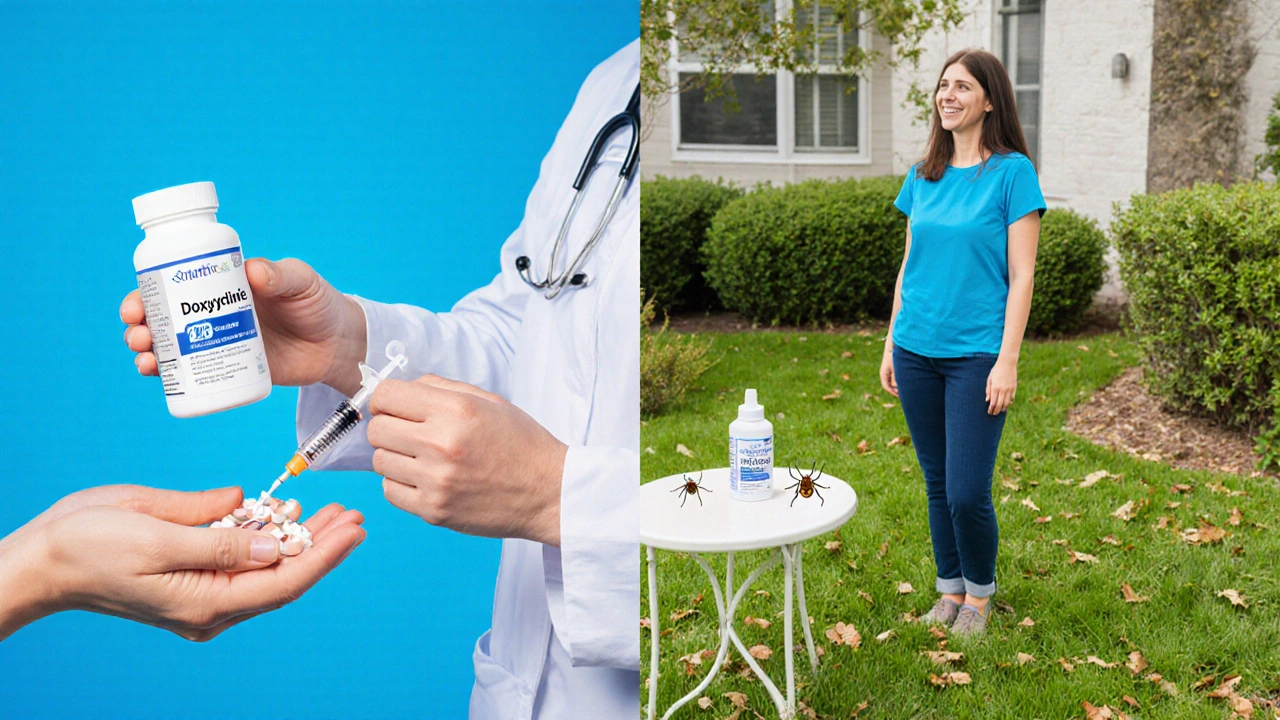Tick Fever Symptom Checker
Select the symptoms your dog is currently experiencing. This tool helps identify possible Tick Fever indicators and suggests when to consult a veterinarian.
Potential Tick Fever Indicators
When a dog contracts Tick Fever (also known as canine ehrlichiosis, a bacterial infection transmitted by ticks), the illness can progress quickly if left untreated. Dog owners worry about tick fever because it can cause fever, anemia, and even organ damage.
Key Takeaways
- Tick Fever is caused by the bacterium Ehrlichia canis and spread by ticks.
- Early signs include fever, lethargy, loss of appetite, and swollen lymph nodes.
- Veterinarians use blood work (CBC), serology (ELISA), and molecular testing (PCR) to confirm the diagnosis.
- Doxycycline is the first‑line antibiotic; Imidocarb is used for severe cases.
- Regular tick prevention and prompt removal are the best defenses.
What Is Tick Fever?
Tick Fever, formally called Canine Ehrlichiosis, is an infectious disease caused by the intracellular bacterium Ehrlichia canis. The pathogen lives inside white blood cells and multiplies after a tick bite. The most common vector in North America is the brown dog tick (Rhipicephalus sanguineus), though other species can also transmit it.
Dogs of any breed or age can be infected, but puppies and older dogs are especially vulnerable because their immune systems are weaker. Outdoor dogs, hunting companions, and pets living in tick‑infested regions face the highest risk.

Common Symptoms in Dogs
The disease progresses in three stages: acute, sub‑clinical, and chronic. Recognizing the early, acute signs is key to preventing long‑term damage.
- Fever - often intermittent and higher than 103°F (39.4°C).
- Lethargy or sudden loss of energy.
- Loss of appetite and weight loss.
- Bleeding tendencies - bruises, nosebleeds, or enlarged spleen.
- Swollen lymph nodes, especially around the head and neck.
- Eye problems such as uveitis or retinal hemorrhage.
- Joint pain that may mimic arthritis.
If untreated, dogs can enter the chronic phase, showing anemia, severe weight loss, and organ failure.
How Vets Diagnose Tick Fever
Diagnosis starts with a thorough physical exam and a detailed history of tick exposure. Blood work helps reveal the disease’s footprint.
- Complete Blood Count (CBC) - often shows low platelet count (thrombocytopenia) and mild anemia.
- Serology - enzyme‑linked immunosorbent assay (ELISA) detects antibodies against Ehrlichia canis. Positive results indicate exposure but not necessarily active infection.
- Molecular testing - polymerase chain reaction (PCR) amplifies bacterial DNA and is the most definitive way to confirm an active infection.
Below is a quick comparison of the three most common diagnostic tools.
| Test | What It Detects | Time to Result | Cost (US$) |
|---|---|---|---|
| CBC | Low platelets, anemia | 30‑60 minutes | 15‑30 |
| ELISA | Antibodies (exposure) | 2‑4 hours | 40‑70 |
| PCR | Bacterial DNA (active infection) | 24‑48 hours | 80‑120 |
Treatment Options
Once diagnosed, prompt antimicrobial therapy can clear the infection in most dogs. The choice of drug depends on disease stage, severity, and any concurrent health problems.
- Doxycycline - the gold‑standard antibiotic. A typical regimen is 5 mg/kg PO (by mouth) twice daily for 28 days. It penetrates intracellular bacteria effectively and has a relatively low side‑effect profile.
- Imidocarb - used for severe or refractory cases, especially when thrombocytopenia is profound. Administered as an injection, dosage is 5‑8 mg/kg IM (intramuscular) or IV, repeated after 14 days.
- Supportive care - fluids, blood transfusions, or anti‑inflammatory meds may be needed for dogs in the chronic stage.
The table below highlights key differences between doxycycline and imidocarb.
| Attribute | Doxycycline | Imidocarb |
|---|---|---|
| Administration | Oral tablets | Injectable |
| Typical Course | 28 days | Two doses, 14 days apart |
| Side Effects | Gastrointestinal upset | Potential liver toxicity, pain at injection site |
| Cost (US$) | 30‑50 | 70‑100 |
| Effectiveness | 90‑95% cure rate in acute cases | Used when doxycycline fails or severe anemia |

Prevention and Tick Control
Preventing a tick bite is far easier than treating an infection. Here are proven steps:
- Use a veterinarian‑recommended monthly tick preventative (e.g., fipronil, fluralaner, or selamectin). These products kill or repel ticks before they can attach.
- Perform a daily tick check after walks in wooded or grassy areas. Pull ticks with tweezers, grasping close to the skin, and clean the bite site.
- Keep your yard tidy: mow grass weekly, trim shrubs, and remove leaf litter where ticks thrive.
- Consider environmental acaricides in high‑risk zones, especially if you live in endemic areas.
- Vaccination is not widely available for canine ehrlichiosis in the United States, so rely on chemical preventatives.
When to See a Veterinarian
If you notice any of the following, schedule a vet visit immediately:
- Persistent fever lasting more than 24 hours. \n
- Bruising, nosebleeds, or bleeding gums.
- Sudden loss of appetite accompanied by rapid weight loss.
- Swollen lymph nodes or eye inflammation.
- Lab results showing low platelets or anemia.
Early intervention can dramatically improve outcomes and reduce the chance of chronic organ damage.
Frequently Asked Questions
Can tick fever be cured?
Yes. Most dogs recover fully when treated early with doxycycline. Severe or chronic cases may need additional supportive care, but a cure is still possible.
How long does it take for symptoms to appear after a tick bite?
Symptoms typically emerge 1‑3 weeks after the bite, though some dogs remain asymptomatic for months.
Is there a blood test that can detect tick fever before symptoms start?
PCR can detect bacterial DNA weeks after infection, even if the dog looks healthy. Routine screening is advised for high‑risk dogs.
Can my dog get tick fever more than once?
Yes. Immunity after infection is not complete, so reinfection can occur, especially in tick‑heavy environments.
Are there any natural remedies that work against tick fever?
No substitute matches prescription antibiotics. Natural tick repellents can reduce bites, but once the bacteria are inside the dog, veterinary medication is required.


Comments
Honestly, most people skim the guide and miss the crucial tick‑prevention steps.
I gotta say, this whole thing about tick fever is kinda a big deal for any dog lover, especially if you live in a place where ticks love to hang out. First off, the symptoms list is super thorough, but you gotta actually check your pooch daily, not just when they act weird. You know, those little ticks can hide in the fur and you might not even notice until the fever hits. Also, the part about doxycycline being the go‑to drug – yeah, that's solid, but watch out for any stomach upset, okay? I mean, the guide mentions supportive care, but doesn't stress enough how important fluids are when a dog is losing blood.
And about the diagnostics – the CBC, ELISA, PCR trio – that's the gold standard, but some vets might skip PCR because of cost. You should definitely ask for it if your dog is in the acute stage. Lastly, the prevention tips are on point; just remember to treat your yard too, not just the dog.
People think tick fever is rare, but the truth is parasites are everywhere. The guide nails the basic signs, yet many owners ignore subtle changes. If you see a slight drop in appetite, that could be the first clue. Better safe than sorry – get the blood test early.
Wow, such a comprehensive guide! 😏 I love the emoji‑friendly tone, but seriously, if you skip the tick checks, you're just asking for trouble. Keep those pups safe and maybe add a cute dog meme for motivation? 😂
Reading this felt like watching a drama unfold – the fever, the bleeding, the heroics of doxycycline! 😢🩺 If only every vet could be this thorough, we'd have fewer sad stories. Stay strong, fur‑friends.
Let me break this down step by step, because the journey from tick bite to full‑blown fever is a marathon, not a sprint. First, the tick attaches and injects Ehrlichia canis, which silently multiplies inside the white blood cells. While many owners think their dog will just shake it off, the bacteria actually hijack the immune system, leading to intermittent fevers that can climb over 103°F.
Second, the subtle signs – lethargy, loss of appetite – often get dismissed as “just being a lazy dog,” but they are the body's early alarm bells. Third, the lab work – a CBC revealing thrombocytopenia is a red flag that should never be ignored, even if the dog looks okay. Fourth, the serology can show exposure, but it doesn’t confirm active infection; that’s where PCR shines, catching the bacterial DNA even before antibodies appear.
Fifth, treatment with doxycycline is effective in about 90‑95% of acute cases, yet compliance is key – you must finish the full 28‑day course, not just stop when the dog seems better. Sixth, the side effects like mild gastrointestinal upset are manageable with food, but never sacrifice the full regimen. Seventh, for severe cases, the guide mentions imidocarb, but remember it carries a risk of liver toxicity, so liver enzymes should be monitored.
Eighth, preventatives such as fipronil, fluralaner, or selamectin are your frontline defense; missing a month can let a tick slip through. Ninth, daily tick checks after walks are non‑negotiable – use fine‑tipped tweezers, grab close to the skin, and clean the bite site. Tenth, environmental control – mowing the grass, clearing leaf litter, and possibly using acaricides in high‑risk zones – reduces the tick reservoir. Eleventh, remember that reinfection is possible; immunity isn’t absolute, especially in tick‑heavy areas. Twelfth, chronic stages can lead to anemia, severe weight loss, and organ failure, making early detection vital. Thirteenth, supportive care like fluids or blood transfusions may be required in the chronic phase. Fourteenth, owners should watch for eye inflammation – uveitis can be a silent killer. Fifteenth, always keep a record of symptoms and test results to share with your vet, which speeds up decision‑making. In sum, vigilance, early testing, and strict adherence to treatment protocols are the pillars of conquering tick fever.
Great points on the importance of completing the doxycycline course. Even if the dog seems better, stopping early can let the bacteria hide and cause a relapse later.
Excellent summary of diagnostic tools. Remember, PCR is the most definitive if you suspect an active infection despite a negative ELISA.
Life is a series of choices, and choosing proper tick prevention is choosing peace of mind. The guide nails that philosophy, reminding us that prevention beats cure every time.
Reading this feels like a gentle reminder from a wise friend. Keeping an eye on those subtle symptoms can really save a furry companion.
Thanks for the thorough breakdown. I’d add that consistent communication with your veterinarian, especially when labs shift, can prevent the transition to the chronic stage.
Honestly, the guide could have cut the jargon a bit; most pet owners aren’t looking for a textbook.
Sure, let’s all ignore the vet’s advice and hope a home remedy works. 🙄
Yo! This is spot on! Just remember to check the dog’s paws after every hike!!
While the guide is solid, I’d argue that relying solely on chemical preventatives ignores the ecological balance 🍃. Consider integrated pest management as a complementary strategy.
Great discussion, everyone! Let’s keep sharing tips and experiences so we all become better tick‑fighters.